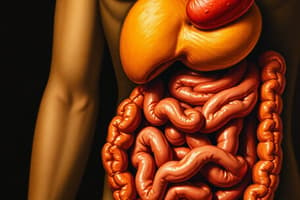Podcast
Questions and Answers
What describes the primary difference between autotrophic and heterotrophic nutrition?
What describes the primary difference between autotrophic and heterotrophic nutrition?
- Autotrophic organisms obtain energy from consuming other organisms.
- Autotrophic organisms cannot utilize organic substances for nutrition.
- Heterotrophic organisms rely on other organisms for their nutritional needs. (correct)
- Heterotrophic organisms can produce their own food through photosynthesis.
Where does the process of physical digestion primarily occur in the human body?
Where does the process of physical digestion primarily occur in the human body?
- Mouth, stomach and esophagus (correct)
- Mouth and esophagus
- Liver and pancreas
- Stomach and large intestine
Which of the following best describes peristalsis?
Which of the following best describes peristalsis?
- The breakdown of food into simple sugars in the mouth.
- The voluntary control of food movement in the digestive system.
- A series of rhythmic contractions that push food along the alimentary canal. (correct)
- The absorption of nutrients through the intestinal walls.
What substance is food referred to as after it exits the mouth?
What substance is food referred to as after it exits the mouth?
What is the primary role of mucous in the stomach?
What is the primary role of mucous in the stomach?
Which part of the small intestine is primarily involved in digestion?
Which part of the small intestine is primarily involved in digestion?
What is one function of the liver within the digestive system?
What is one function of the liver within the digestive system?
Which part of the large intestine is specifically responsible for the storage of feces?
Which part of the large intestine is specifically responsible for the storage of feces?
What is the main function of bile in the digestive process?
What is the main function of bile in the digestive process?
Flashcards are hidden until you start studying
Study Notes
Nutrition Overview
- Nutrition defines how organisms acquire food.
- Autotrophic nutrition: Organisms produce their own food.
- Heterotrophic nutrition: Organisms depend on consuming others for food.
Alimentary Canal
- Another name for the alimentary canal is the gut.
- Major functions of food include energy provision, cell growth and repair, and defense mechanisms.
Stages of Human Nutrition
- Five stages include ingestion, digestion, absorption, assimilation, and egestion.
Types of Digestion
- Physical digestion: Breaks down food from large to small pieces; occurs in the mouth, stomach, and esophagus.
- Chemical digestion: Breaks down food into simpler nutrients using enzymes and acids; primarily occurs in the mouth, stomach, and duodenum.
Dental Anatomy
- Human dental formula: I 2/2, C 1/1, PM 2/2, M 3/3.
- Amylase is the enzyme in the mouth that converts starch to maltose.
Digestive Environment
- Mouth has a pH range of 7-8; stomach pH ranges from 2-3.
Peristalsis and Muscle Types
- Peristalsis involves the alternating contraction and relaxation of alimentary canal muscles facilitating food movement.
- Involuntary muscles line the alimentary canal, stimulated by fiber.
- Food exiting the mouth is called bolus.
Stomach Functionality
- The epiglottis prevents food from entering the trachea during swallowing.
- Gastric juice incorporates hydrochloric acid, pepsinogen, and mucous.
- Hydrochloric acid functions to kill bacteria and activate pepsin, while mucous protects the stomach lining.
Digestion Products
- Physical digestion in the stomach churns food into a liquid called chyme.
Small Intestine Structure
- The small intestine is composed of two parts: ileum and duodenum.
- Digestion primarily occurs in the duodenum.
Nutrient Absorption
- The ileum's adaptations include length for absorption efficiency, villi and microvilli for increased surface area, and abundant capillaries for nutrient transfer to blood.
Accessory Organs
- The pancreas aids digestion through hormone (insulin) production and digestive enzyme secretion.
- The liver produces bile, breaks down old blood cells, stores fat-soluble vitamins and glycogen, produces cholesterol, and deaminates unnecessary proteins.
Bile and Large Intestine
- Bile is stored in the gallbladder and functions to emulsify fats and neutralize stomach acid.
- Components of the large intestine include the colon, caecum, appendix, rectum, and anus.
- The rectum is where feces are stored; functions of the large intestine include reabsorbing water and absorbing B vitamins.
Digestive Disorders
- Stomach ulcers cause burning pain in the abdomen as a common symptom.
Studying That Suits You
Use AI to generate personalized quizzes and flashcards to suit your learning preferences.




